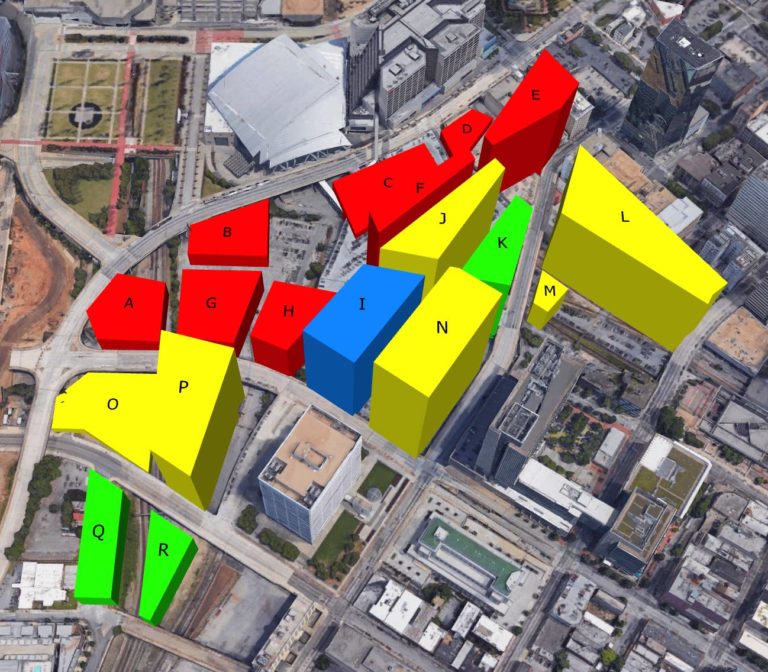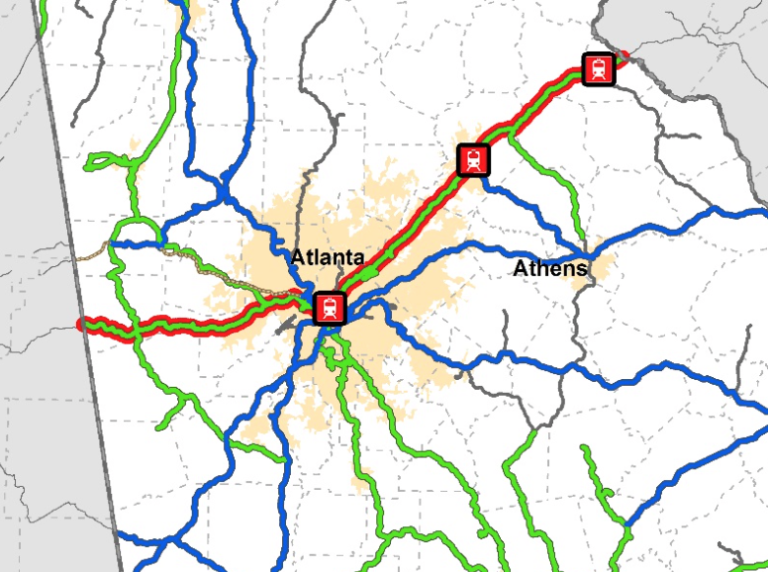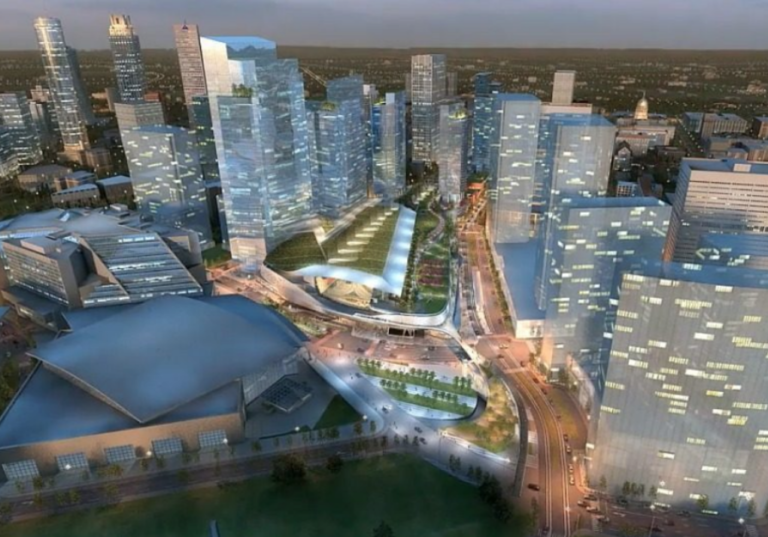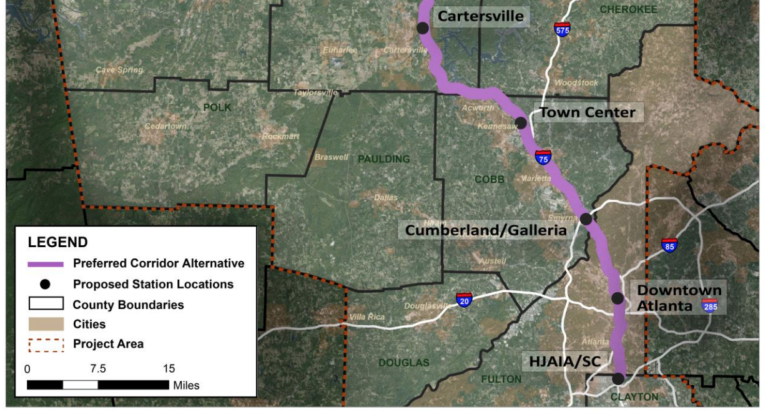Grand plans are moving forward for Downtown Atlanta’s Gulch, a tangle of railroad tracks and parking lots that has long been a gap in the city’s urban fabric. A proposal by Los Angeles-based CIM Group calls for a massive development to include 10 million square feet of office and retail alongside thousands of new apartments and hotel rooms. One thing it apparently isn’t calling for, though: room for long-planned passenger rail.
The project, scheduled to go before the SPI-1 Downtown District Development Review Committee this Thursday, is assumed to be connected to Atlanta’s bid for Amazon’s proposed HQ2, which could bring as many as 50,000 new tech jobs to the city. (Atlanta learned that it was one of 20 shortlisted cities for HQ2 last week.)
For urbanism advocates, the Gulch is of critical importance; not just as a large piece of real estate in the heart of Downtown, but also as one of the most important sites in the region for transit connectivity.
In addition to providing direct connections to two MARTA stations – including Five Points, the system’s hub – it sits at the focal point of the region’s railroad network. Any plan to serve Downtown with commuter or intercity rail would certainly involve the Gulch. We must ensure that development here is done in such a way that it doesn’t preclude major transit improvements. Alarmingly, the initial plans filed by CIM would do just that.
9,000 parking spaces, but no room for trains

RED: retail/office; YELLOW: office; BLUE: hotel; GREEN: residential
Although the CIM proposal plays up the project’s commitment to transit and other non-driving modes (the SAP application speaks of creating “an urban environment that promotes strong transit ridership and investment in alternative transportation”), the actual plans call for filling the Gulch with 9,000 parking spaces, with the development to be built on top. Think Atlantic Station but bigger, and in the middle of Downtown. Plans show this parking being built in way that would effectively rule out any future expansion of rail capacity in the heart of Downtown.

What the Gulch and its rail capacity mean to Atlanta
The history of the Gulch as a railroad hub is as long as the history of Atlanta itself. The site is the point of convergence for the three historic railroad lines that are responsible for Atlanta’s existence as a city – The Georgia Railroad connecting east, the Macon & Western connecting south, and the state-chartered Western & Atlantic connecting north. All three corridors remain in use today, operated by the railroads’ modern-day successors, Norfolk Southern and CSX (though notably, the W&A corridor is still owned by the State of Georgia).
For much of late 19th and 20th centuries, what is now the Gulch was the pulsing heart of passenger rail transportation in Georgia. Atlanta’s two grand rail terminals, Union Station and Terminal Station, were both located here. Passenger rail began a slow decline as we entered the postwar era of heavily-subsidized highway travel; both stations were demolished in 1972, and the Gulch took on its current incarnation as a vast expanse of surface parking.

Multimodal Passenger Terminal: don’t derail this
Interest in restoring passenger rail service to Downtown has surfaced occasionally in recent decades; official plans by the Georgia Department of Transportation envision a network of up to nine commuter lines radiating in all directions from Downtown; separate studies have proposed intercity rail connections to Charlotte, Columbus, and Chattanooga. At the heart of these networks would be a modern Downtown rail station roughly on the site the demolished Union and Terminal Stations – i.e., the Gulch. Generally referred to in recent planning documents as the Multimodal Passenger Terminal or MMPT, plans for a contemporary Downtown terminal have been through several iterations.
The MMPT’s long history as “just a proposal” has led some planners and observers to dismiss the project as one that is perpetually discussed but never acted on. But consider the rapidly changing political environment that surrounds the project, and transit as an issue in general. We shouldn’t give up on a potentially transformational project at the moment it is on the cusp of a breakthrough.

Until very recently, large-scale transit investment had little to no traction at the State Capitol – or anywhere outside of Fulton and DeKalb Counties, for that matter. It’s only in the last five years that this has begun to change, and in a big way. Clayton County joined MARTA in 2014, and both Gwinnett and Cobb are now having serious conversations about transit. Meanwhile, it appears the state legislature is finally warming to the issue after decades of resistance. Many of the technical challenges that have hampered the MMPT’s progress – e.g. a stated lack of intown rail capacity by the railroads – are eminently solvable problems given sufficient political will and resources.
Chattanooga to Atlanta high-speed rail
A preferred route for an Atlanta to Chattanooga High-Speed Rail line was announced only a few months ago by the U.S. Department of Transportation. The report only mentions one station in the City of Atlanta limits: Downtown. And it refers specifically to the MMPT. Given that, here are some questions we need to be asking:
Are we going to allow one development to destroy the potential for that level of intercity rail connectivity?

How can we think of this development, even if it’s part of an HQ2 win, as beneficial if it’s limiting a crucial passenger rail connection, one that’s at the heart of a city founded upon the potential of rail transportation?
Why would Amazon even be interested in a city that is willing to squash its own potential?
If you look at the appendix to the report you’ll see that the alternative route alignments failed in part because they didn’t “connect to the planned multi-modal passenger terminal (MMPT) in downtown Atlanta including the planned commuter rail and bus services serving the MMPT.” It’s not going too far to say that the very future of high-speed, intercity transportation in the deep south depends on this.
Interest in a more extensive rail network is growing
Just in the past six months, we have seen a flurry of renewed interest in rail among public officials. In August, State Sen. Brandon Beach, chair of the Senate Transportation Committee and a longtime leader on transit at the Gold Dome, suggested that the time was right to reconsider the MMPT (“We need to have a Union Station-type facility,” he said).
Earlier this month, at the annual “State of MARTA” Breakfast, MARTA Chair Robbie Ashe was reported saying that he “hopes the agency will eventually establish Georgia’s first commuter-rail service in Clayton County.” And in a response as candidate to a business group’s questionnaire, now-Mayor Keisha Lance Bottoms pledged to “call upon the ARC and MARTA to explore working with private rail line owners for the use of commercial rail lines by our transit system.”
Prime real estate for offices and transportation
Each of those statements speaks to an increased interest at all levels of government – state, city, and region – in using our extensive rail network for increased commuter and passenger traffic. And under any such scenario, a Downtown terminal at the Gulch site will play an integral role. Even if commuter or intercity rail serving Downtown is still years out, it is essential that we keep this option open.
Of course, whether we build out the Gulch as a regional transit terminal or as a massive mixed-use development is not an “either-or” proposition. It is entirely possible to accommodate both – in fact, the two uses would complement each other quite well.
Decisions that are made in the the coming months regarding this property will affect the future not just of Downtown but of the entire city and region for decades. Let’s make the right ones.
CALL TO ACTION
Please share this post with your city and state elected officials and on your Facebook page! Start to raise awareness of this issue now.
Georgia State Senator Brandon Beach has been a vocal advocate for the MMPT and intercity rail in the General Assembly, and he also serves as chair of the Senate transportation committee. Make sure he knows this is important!
The guest post comes from David Emory, a civic technology consultant and longtime sustainable transportation activist who currently serves as chair of the Georgia Sierra Club and as a board member of Citizens for Progressive Transit.
